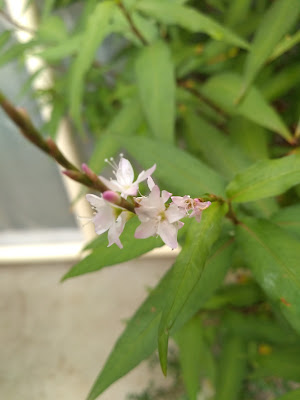I grow a few different strawberries, some different species and some garden strawberries. One of the species of wild strawberries I grow is Fragaria virginiana.
 |
| Fragaria virginiana strawberries |
F virginiana comes from North America. This species was used as one of the two main parents to develop the garden strawberries that you can buy from the shops. This was used as a parent due to its great taste, the other parent was used for its larger sized berries.
The taste of these berries is similar to a garden strawberry, but nicer, and more concentrated. The original berries were too small for my liking, so I decided to do some breeding for larger berry size.
 |
| Larger F virginiana strawberries |
When I first got seeds of this plant they took a while to grow to maturity, the resultant berries were about the size of your finger nail. The berries tasted great, but were too small. Even the smallest berries in the photos are larger than the original berries. I don't know what size berry is normal for this species, I know there are several cultivars overseas with larger berries. I think the wild ones tend to be a lot smaller.
I originally obtained seed that had been collected from the wild. These tiny berries certainly had great taste. They also had a lot of genetic diversity, which made this selective breeding project a lot simpler.
I collected seed, grew out a lot of plants, culled the ones with the smaller berries, and grew seeds from the ones with the largest berries. I did this for a few years.
It takes time for these to go from seed to fruit, and these only flower once or twice per year in my garden, so this project took quite a while before I could see any progress.
Saving seed from strawberries, and growing it out to maturity, is fiddly. Luckily you get a lot of seed per berry, and a lot of genetic diversity combined with a lot of seed means there is a good chance of stumbling across the right plant. Growing out large numbers helps your chances of getting the right genetic combination.
 |
| Some are too small and will be culled |
After a few generations it was clear that the berries are significantly larger than the original ones. As you can see in my photos, some plants produce larger berries than others. It takes the same space and effort to grow tiny berries as it does larger berries, so the smaller ones are culled.
This is still the same species, it has not crossed with any other species, or messed around with ploidy levels. I have selected for larger berries through growing many seedlings and culling hard. Some of the smaller ones also don't look typical of this species, given they open pollinated they may have crossed, so I have also culled anything that appears to be an off type.
These plants all produce runners in my garden. This means I am able to cull the smaller ones and propagate the larger ones quickly and easily. If they did not produce runners it would likely mean another 15 or so years of growing out seeds to produce a stable variety, so runners are great. Runners also mean the plants spread to different parts of my garden, if we have another dry summer that kills off lots of things there is a chance one runner will be sitting somewhere protected and I will be able to us it to restart the patch.





























































